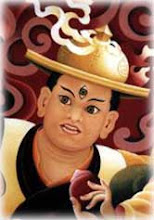Fifth and final part of setting the record straight on Pico Iyer's book, Open Road, The Global Journey of the Fourteenth Dalai Lama.
On the false view of non-sectarianism
p 121
In effect, he seemed to be bringing out into the world two sometimes unrelated treasures, each of them explosive, one was Tibet and it’s particular culture, often hard to translate into other tongues, and the other was his brand of Buddhism. To mass general audiences, he always stressed “on crazy wisdom,” as you could call it, because philosophy seemed a way to cut through all the divisions to some universal human core. (“Sectarianism is poison,” he writes in an unusual violent statement in his second autobiography.) When he spoke of Nalanda Buddhism, “in honor of ancient Buddhism University in India from which his tradition’s great philosophers had emerged, he was essentially suggesting that reason and universality could offer places where Gelug practitioner and Kagyu, eastern Tibetan and central, American and Chinese could come together.
“His brand of Buddhism” is a very interesting phrase because that's what it is. What the Dalai Lama is promoting is his very own version of Buddhism, a sort of amalgamation of the traditional Tibetan Buddhist schools of Nyingma, Kagyu, Sakya and Gelugpa. He has referred to it a couple of times now, most recently in Nottingham in May 2008.
What is 'Nalanda Buddhism'? In this context, it is quite simply the Dalai Lama's break with tradition. He advertises it as tradition by using the name of a famous monastic university in India and quoting the names of great Masters such as Nagarjuna, but the truth is that the Dalai Lama is now his own tradition. He wasn't the Head of any school of Tibetan Buddhism so he created his own tradition. He calls it 'rigme' or “non-denominational”. It seems that to arrive at this tradition you pick which bits of Tibetan Buddhism you like (principally Dzogchen teachings) and graft on a bit of philosophy. You also throw out any unique quality of each existing Tibetan Buddhist tradition (such as the traditionally chosen Karmapa or the Buddhist Deity Dorje Shugden), and that is when the problems start.
Divide and rule is the method of this tradition, producing a non-denominational mish-mash of the Dalai Lama's making, masquerading as mainstream Buddhism through the power of his celebrity.
The Dalai Lama has a very strange idea of non-sectarianism. He says “sectarianism is poison” but his idea of sectarianism is practising one spiritual tradition purely. Therefore, to be non-sectarian, one has to receive teachings from all Buddhist schools and practise each one. In an interview in Nottingham in May 2008 he said:
“My approach is promotion of non-sectarian. I myself receive teaching from all different Tibetan Buddhist sect”
If each tradition of Tibetan Buddhism has a complete path to enlightenment, why do we need to receive teachings from all of them? Surely it is fine to practise one while maintaining respect and good relationships with the others? This is true non-sectarianism.
What the Dalai Lama calls non-sectarianism is mixing traditions. What the Dalai Lama calls the “Nalanda Tradition” is his attempt to merge all the schools of Tibetan Buddhism together under his leadership. Therefore, for “Nalanda Tradition” read “tradition of Buddhism created by the Dalai Lama by merging the present traditions of Tibetan Buddhism under a false premise of non-sectarianism that allows the Dalai Lama to do as he pleases.”
Pico Iyer says:
....he was essentially suggesting that reason and universality could offer places where Gelug practitioner and Kagyu, eastern Tibetan and central, American and Chinese could come together.
No, he was essentially suggesting that there could be a tradition of Buddhism that the Dalai Lama has created and is the supreme leader of, and that encompasses all Buddhists. This is what the Dalai Lama has worked for: supreme religious and political power. He's a politician in the robes of a monk, causing confusion by that very dichotomy; posing as a religious authority when he is not the head of any school of Buddhism, speaking words like 'religious freedom' and 'harmony' while he destroys both.
For Buddhist practitioners to come together is very simple. We don’t all need just one tradition of Buddhism that everyone can subscribe to – we simply need to be left alone with the religious freedom to practise our individual traditions as our Gurus have taught us, while respecting without discrimination the differences and uniqueness of the different sects of Buddhism.
We also need a certain Dalai Lama to stop sowing words of disharmony in the Buddhist community and creating schisms where they ought not to be.
Click here for Part One, Part Two, Part Three and Part Four.
Posted courtesy of Lineage Holder.
Roofing Contractors in Florida
8 years ago





No comments:
Post a Comment